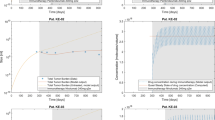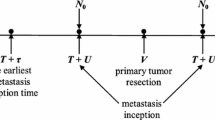Abstract
Classification of cancer as localized or metastatic disease remains the mainstay for determining the best therapeutic strategy to be undertaken at bedside. Although simple, this classification may underestimate the risk of undetectable, early metastatic stages. Many studies have been performed to identify prognostic biomarkers for evaluating the risk of metastatic relapse in patients with apparently localized disease. Here, we have developed an original mathematical model designed to calculate a Metastatic Index. This Metastatic Index should enable to better predict the risk of invasive cancer, even when it does not show with standard imaging techniques. Further validation steps are ongoing, both in tumor-bearing animals and as part of retrospective comparisons with clinical data. This new tool should help the clinician to undertake systemic treatment at the earliest stages of the disease, thus allowing a better efficacy eventually.
Résumé
La stratégie de traitement d’une tumeur solide repose fondamentalement sur le classement initial entre maladie localisée ou avancée. Or, il est possible que des états métastatiques précoces ne soient pas mis en évidence lors des bilans d’extension. Ce risque implicitement reconnu justifierait pourtant l’usage de thérapies adjuvantes après traitement radical de type exérèse chirurgicale. Un grand nombre de travaux ont déjà été réalisés afin d’identifier des marqueurs pronostiques permettant de préciser ce risque invasif chez des patients dont la maladie était apparemment localisée. Dans ce contexte, notre étude, basée sur une modélisation mathématique originale, présente un nouveau marqueur, l’index métastatique (IM), permettant de donner une estimation du nombre et de la taille des métastases en fonction du temps. À terme, cette technologie pourrait fournir un nouvel outil décisionnel précieux permettant de prédire le risque d’évolution métastatique et éclairer au mieux le clinicien sur l’intérêt d’un éventuel traitement adjuvant.
Similar content being viewed by others
Références
Akanuma A (1978) Parameter analysis of Gompertzian function growth model in clinical tumors. Eur J Cancer 14: 681–688
Barbolosi D, Benabdallah A, Hubert F, et al (2009) Mathematical and numerical analysis for a model of growing metastatic tumors. Math Biosc 218: 1–14
Ciccolini J, Mercier C, Dahan L, et al. (2011) Integrating pharmacogenetics into gemcitabine dosing-time for a change? Nat Rev Clin Oncol [Epub ahead of print]
Coate L, Cuffe S, Horgan A, et al (2010) Germline genetic variation, cancer outcome, and pharmacogenetics. J Clin Oncol 28: 4029–4037
Cuzick J (2010) Controversies in design and interpretation of adjuvant clinical trials. Cancer Invest 28: 28–34
Elias D (2006) Rationnel de la chirurgie oncologique au sein du traitement multimodal des cancers. Bull Cancer 93: 775–781
Karp G, Bouharmont J, Wissoq JC (2004) Biologie cellulaire et moléculaire. De Boeck 850
Keshtgar M, Davidson T, Pigott K, et al (2010) Current status and advances in management of early breast cancer. Int J Surg 8: 199–202
Koscielny S, Tubiana M, Le MG, et al. (1984) Breast cancer. Relationship between the size of the primary tumour and the probability of metastatic dissemination. Br J Cancer 49: 709–715
Kronqvist P, Kuopio T, Nykänen H, et al (2004) Predicting aggressive outcome in T1N0M0 breast cancer. Br J Cancer 91: 277–281
Meille C (2009) Modélisation du risque des toxicités induites par des substances thérapeutiques. Université de la Méditerranée, thèse d’université, 31 mars
Meille C, Iliadis A, Barbolosi D, et al (2008) An interface model for dosage adjustment connects hematotoxicity to pharmacokinetics. J Pharmacokin Pharmacodyn 35: 619–633
Peeters C, de Geus LF, Wetphal JR, et al. (2005) Decrease in circulating antiangiogenic factors after emoval of primary colorectal carcinoma coincides with increased metabolic activity of liver metastases. Surgery 137: 246–249
Spielmann M, Khalil A, André F (2006) Cinétique de prolifération tumorale et efficacité de la chimiothérapie adjuvante. Étude de l’activité mitotique. Cancer du sein. Springer, Paris, pp 455–63
Viens P, Roché H, Kerbrat P, et al. (2001) Epirubicin-docetaxel combination in first line chemotherapy for patients with metastatic breast cancer. J Clin Oncol 24: 328–335
Author information
Authors and Affiliations
Corresponding author
About this article
Cite this article
Barbolosi, D., Verga, F., You, B. et al. Modélisation du risque d’évolution métastatique chez les patients supposés avoir une maladie localisée. Oncologie 13, 528–533 (2011). https://doi.org/10.1007/s10269-011-2028-6
Received:
Accepted:
Published:
Issue Date:
DOI: https://doi.org/10.1007/s10269-011-2028-6




